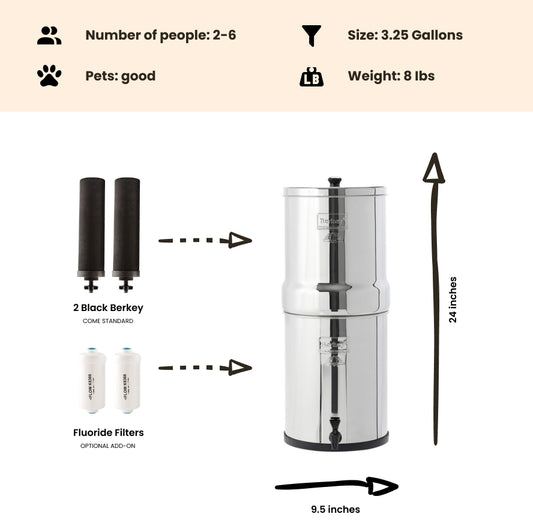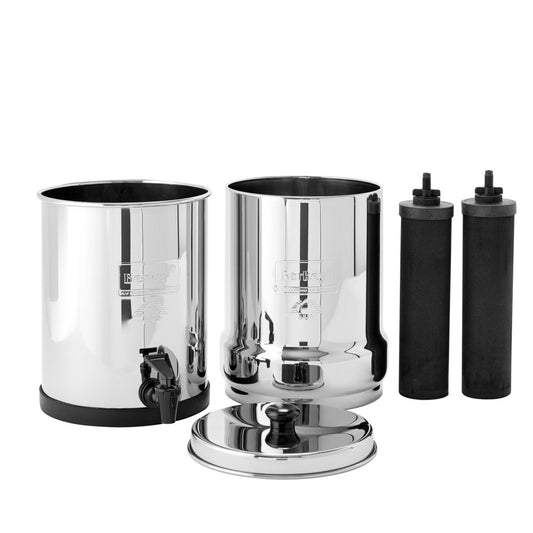
Arsenic in Drinking Water
By Dan DeBaunShare
Arsenic is a toxic heavy metal that occurs naturally in rocks and soils, and can leach into groundwater. Because arsenic is so widespread all around the world, it is a common drinking water contaminant in many countries, including much of the United States. Exposure to arsenic through contaminated drinking water or food can have several debilitating health effects and has been associated with various forms of cancer, including skin, bladder, lung, liver and kidney cancer.
What are acceptable levels of arsenic in water?
In 2006, the US Environmental Protection Agency (EPA) revised the standard for safe arsenic levels in drinking water from 50 parts per billion (ppb) down to 10 ppb. The maximum allowable safe levels of arsenic in drinking water was reduced as new scientific evidence has begun to highlight the long-term health impacts of exposure to arsenic in drinking water. However, while the new drinking water standard does help protect consumers who get their drinking water from a public drinking water supply, when it comes to safe arsenic levels in well water, homeowners who rely on well water for their drinking water are largely on their own.
Since well water is not regulated by federal or state arsenic standards, it is not routinely tested. Consequently, well water owners may not even be aware that their water is contaminated and therefore face a higher risk of exposure.
Is arsenic worse for children or adults?
According to the World Health Organization, long-term exposure to arsenic in drinking water can cause skin lesions, as well as other serious health issues such as heart disease, diabetes, and cancer. These health impacts are the same for both children and adults, however, children are susceptible to additional risks when exposed to arsenic.

What does arsenic do to babies?
Exposure to arsenic whilst in the mothers womb or in early childhood can significantly impact growth and development of babies. Effects of arsenic on babies include poor physical and cognitive development, as well as poor health and increased mortality later life. One study showed that pregnant and/or breast-feeding mice given drinking water containing legal levels (10 ppb) of arsenic had disrupted lipid metabolism, leading to a reduction in nutrients in their blood and breast milk. Due to less nutrients being available to the fetus or baby, growth of offspring from arsenic exposed mothers was significantly stunted. The study found that arsenic exposure while pregnant is not only detrimental to the baby, but can also cause fatty liver disease (which is associated with health effects such as hypertension, diabetes, obesity, and high cholesterol) in the mother.
Another study found that babies exposed to arsenic in their mother's womb face an increased risk of infection and respiratory illness in the first year of their life.
Why are children more susceptible to arsenic?
Growing children have smaller bodies, and consume more food and drink more water per pound body weight, compared to adults. Consequently, they ingest more arsenic per pound body weight than adults do. Babies and very young children that are still growing may also not yet have developed mechanisms for efficiently eliminating toxins from their bodies. Consequently, babies and young children are more vulnerable to arsenic toxicity than adults.
Arsenic poisoning symptoms in children may include:
- Red or puffy skin
- Changes in skin pigmentation or condition (for example, the appearance of new skin lesions or warts)
- Tummy aches
- Diarrhea
- Nausea/vomiting
- Heart pulpitations
- Muscle cramps
- Tingling sensation in fingers and/or toes
Does exposure to arsenic lower IQ?
Exposure to arsenic in the womb and in early life has been found to affect brain development, resulting in a lower IQ in arsenic exposed children. Building on previous studies that assessed the impact of arsenic exposure on child intelligence conducted in Bangladesh and other countries in South Asia, a recent US study conducted on children living in Maine — where arsenic levels in well water are known to be high — found that children exposed to arsenic in drinking water had significantly low levels of intelligence, which could translate into learning problems and problems with schoolwork. Poor intellectual performance at school can ultimately limit career opportunities and earning potential in adulthood.
Cancer risks from arsenic in drinking water
Arsenic is known to cause skin blemishes and other health effects, but can arsenic cause cancer? Recent scientific studies suggest there is a strong link between arsenic and cancer of the bladder, skin, lungs, liver, kidney and prostate.
One study, conducted on private well owners living in Vermont, Maine and New Hampshire, New England — where the incidence of bladder cancer is 20% higher than other parts of the US — confirmed that arsenic in drinking water raises the risk of bladder cancer considerably.
The study found this risk increased as the cumulative exposure to arsenic contamination increased, and people who consume high volumes of water are twice as likely to get bladder cancer compared to those who drink small amounts of water.
Another study suggests that people who are exposed to arsenic in their drinking water may only experience arsenic-related health effects years later. This means that the incidence of bladder cancer (and other arsenic-related cancers) is likely to remain high in communities that have been exposed to high levels of arsenic in the past, even if measures have been taken to reduce arsenic levels or completely eliminate the exposure.

How to detect arsenic in water
A question well owners commonly ask is 'how can you detect arsenic in water?' Since arsenic does not discolor the water and has no taste or smell, you will most likely not know whether it is present or not, unless you have your well water tested. This typically involves collecting a water sample and sending it to a laboratory for testing.
However, new nanotechnology to detect arsenic in water is currently being developed, which could make detecting arsenic in water much simpler in the future. Using an innovative approach, scientists have developed a smartphone accessory that is able to detect arsenic in water. The device uses bacteria to detect arsenic, and presents the contamination levels visually, much like the bars used to indicate cellphone signal or battery charge remaining. A handy device such as this can potentially give homeowners the power to test their well water on site without needing any specialized laboratory equipment or having to send the sample away for analysis.
Areas with high levels of arsenic in water
In the US, where mostly unregulated well water provides a source of drinking water for around 43 million people, arsenic contamination poses a health risk to residents nationwide. However, since arsenic levels in drinking water vary across the country, the level of exposure, together with the associated health risk varies from state to state.
As mentioned earlier, private well owners living in places in US with high concentrations of arsenic in groundwater — which translates into high arsenic levels in well water — have a higher incidence of arsenic-related health issues, including cancer. The US Geological Survey (USGS), who monitors arsenic levels in water by state, has compiled a map of arsenic in US drinking water across the country. Earlier studies conducted by the USGS found that nearly 7% of the private wells tested failed to meet the drinking water safety standard for arsenic (10 ppb). Regions with the highest levels of arsenic in drinking water include New England, where 20% of private wells are contaminated, and Maine, where arsenic contamination in well water is higher still at up to 45%, affecting around 80,000 residents.

How to safely remove arsenic from drinking water
As there is no state or federal requirement for well owners to regularly test their well water for arsenic, most well owners have no idea if their water is contaminated or not, and if it is, to what degree. Many residents continue to drink well water that hasn't been tested for decades. What is concerning, is that even if well water, or even public drinking water that meets drinking water safety standards, contains arsenic at low levels (<10 ppb), the continuous exposure to low doses of arsenic over time may still cause cancer in ten, twenty or thirty years time.
If you are wanting to find out how to get arsenic out of drinking water for the sake of your future health and that of your family, follow the recommendations outlined below.
Drinking water filter for arsenic
The simplest and easiest way of removing arsenic from drinking water is to use a specialized arsenic filter for drinking water. The best water filter to remove arsenic is the Big Berkey (or any of its little or bigger brothers in the Berkey range) fitted with a set of PF-2 arsenic filters in the lower chamber.
How to filter arsenic from well water
A more pressing issue, given the high rate of contamination in private wells, is what to do about high levels of arsenic in well water.
If you are wondering how can arsenic be removed from well water, there are several options available. You could filter all the water entering your home, but the cost of whole house arsenic water filter could set you back $4000 or more. And that's before annual maintenance costs of around $300. A cheaper, yet extremely efficient, way of removing arsenic is to invest in a good quality point of use home water filter for arsenic, such as a Berkey water filter that come standard with the black berkey filters. These black berkeys will remove arsenic from the water at levels greater than 99.5%.
If you want a second level of protection you can also add the Berkey PF-2 arsenic filter. They incorporate a specialized filter technology that is specifically designed to target and remove fluoride and arsenic from drinking water to keep you and your family safe. While not necessary, they can add even more filtration when arsenic concentrations in your water is very high.
-
Regular price $234.00 USDRegular priceUnit price / per
-
Regular price $327.00 USDRegular priceUnit price / per
-
Regular price From $367.00 USDRegular priceUnit price / per
-
Regular price From $408.00 USDRegular priceUnit price / per
-
Regular price From $451.00 USDRegular priceUnit price / per
-
Regular price From $478.00 USDRegular priceUnit price / per
-
Regular price $332.50 USDRegular priceUnit price / per
$350.00 USDSale price $332.50 USDSale

Dan DeBaun
Dan DeBaun is the owner and operator of Big Berkey Water Filters. Prior to Berkey, Dan was an asset manager for a major telecommunications company. He graduated from Rutgers with an undergraduate degree in industrial engineering, followed by an MBA in finance from Rutgers as well. Dan enjoys biohacking, exercising, meditation, beach life, and spending time with family and friends.
~ The Owner of Big Berkey Water Filters
















It's great to hear that arsenic testing can be done for around $50 or so, not too expensive. My brother wants to make sure his new well is going to be very safe for him and his family. He needs to find a local contractor and plumber to work with that will be able to get this done properly.
Why does the article say "I’m partial to Berkey water filters since they are distinguished for their arsenic removing filter technology and the systems last for many years without needing regular filter replacements typical of others on the market" when the fluride/arsenic filter specs say replace after every 1000 gallons??
Hi Jim -
This is in reference to other systems / filters that require either monthly, 6-month, or yearly replacements. The PF-2's last an average of 2 years for our customers.
Thanks
Dan
Do you have point of use arsenic removal for the shower?
Hi Laura -
No, I'm sorry, but we do not.
Thanks
Dan
Hiya! I simply want to give an enormous thumbs up for the nice information you could have right here on this post. I will probably be coming again to your blog for more soon.